Business Analytics Techniques in Tesco: Insights and Decision Making
VerifiedAdded on 2022/09/14
|13
|3078
|25
Report
AI Summary
This report provides a comprehensive overview of Tesco's application of business analytics. It explores how Tesco utilizes big data, data techniques, and customer behavior analysis to make informed decisions and gain a competitive advantage in the retail market. The report delves into specific examples of data usage, such as loyalty card systems and sensor data, and discusses the insights drawn from this data. It examines how Tesco employs artificial intelligence and data-driven systems to understand customer preferences, improve marketing strategies, and optimize supply chains. Furthermore, the report highlights examples of other companies like Facebook, Amazon and Alibaba to draw parallels and demonstrate the effectiveness of data analytics in the business world. The report concludes by discussing the impact of these insights on Tesco's decision-making processes and the challenges and opportunities that lie ahead for the company in an evolving market environment.

Running head: TECHNIQUES IN BUSINESS ANALYTICS
TECHNIQUES IN BUSINESS ANALYTICS
Name of the Student
Name of the University
Author Note
TECHNIQUES IN BUSINESS ANALYTICS
Name of the Student
Name of the University
Author Note
Paraphrase This Document
Need a fresh take? Get an instant paraphrase of this document with our AI Paraphraser
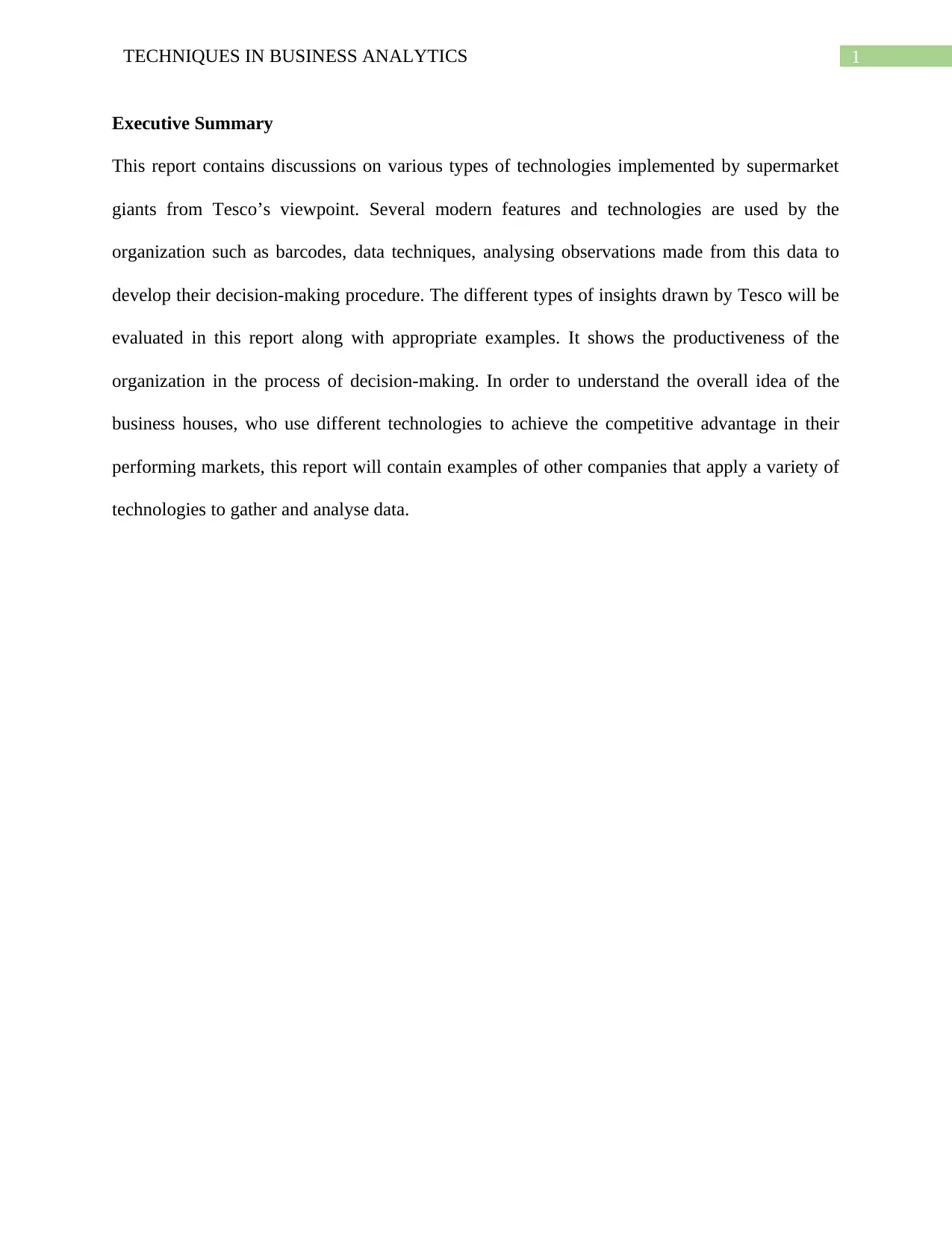
1TECHNIQUES IN BUSINESS ANALYTICS
Executive Summary
This report contains discussions on various types of technologies implemented by supermarket
giants from Tesco’s viewpoint. Several modern features and technologies are used by the
organization such as barcodes, data techniques, analysing observations made from this data to
develop their decision-making procedure. The different types of insights drawn by Tesco will be
evaluated in this report along with appropriate examples. It shows the productiveness of the
organization in the process of decision-making. In order to understand the overall idea of the
business houses, who use different technologies to achieve the competitive advantage in their
performing markets, this report will contain examples of other companies that apply a variety of
technologies to gather and analyse data.
Executive Summary
This report contains discussions on various types of technologies implemented by supermarket
giants from Tesco’s viewpoint. Several modern features and technologies are used by the
organization such as barcodes, data techniques, analysing observations made from this data to
develop their decision-making procedure. The different types of insights drawn by Tesco will be
evaluated in this report along with appropriate examples. It shows the productiveness of the
organization in the process of decision-making. In order to understand the overall idea of the
business houses, who use different technologies to achieve the competitive advantage in their
performing markets, this report will contain examples of other companies that apply a variety of
technologies to gather and analyse data.
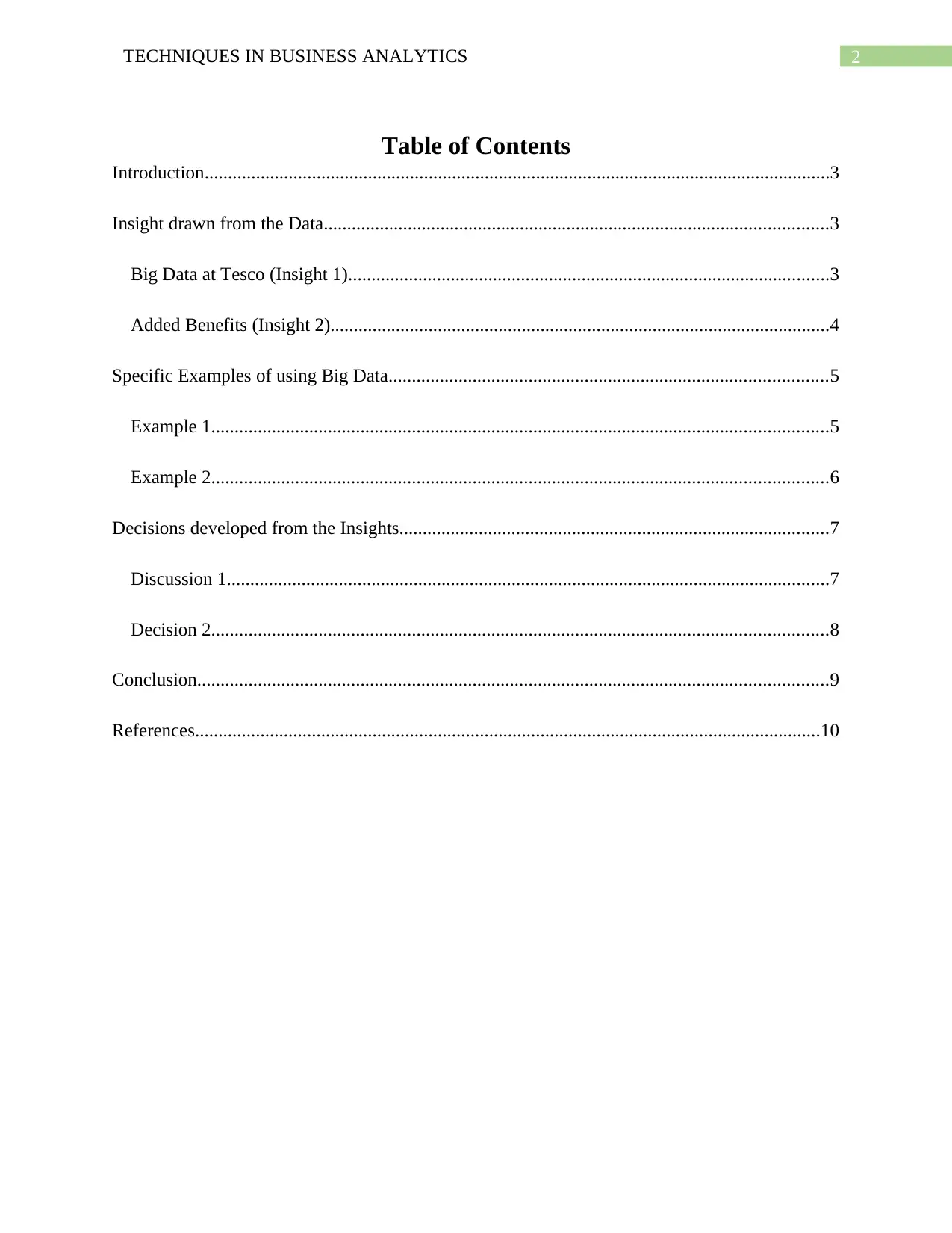
2TECHNIQUES IN BUSINESS ANALYTICS
Table of Contents
Introduction......................................................................................................................................3
Insight drawn from the Data............................................................................................................3
Big Data at Tesco (Insight 1).......................................................................................................3
Added Benefits (Insight 2)...........................................................................................................4
Specific Examples of using Big Data..............................................................................................5
Example 1....................................................................................................................................5
Example 2....................................................................................................................................6
Decisions developed from the Insights............................................................................................7
Discussion 1.................................................................................................................................7
Decision 2....................................................................................................................................8
Conclusion.......................................................................................................................................9
References......................................................................................................................................10
Table of Contents
Introduction......................................................................................................................................3
Insight drawn from the Data............................................................................................................3
Big Data at Tesco (Insight 1).......................................................................................................3
Added Benefits (Insight 2)...........................................................................................................4
Specific Examples of using Big Data..............................................................................................5
Example 1....................................................................................................................................5
Example 2....................................................................................................................................6
Decisions developed from the Insights............................................................................................7
Discussion 1.................................................................................................................................7
Decision 2....................................................................................................................................8
Conclusion.......................................................................................................................................9
References......................................................................................................................................10
⊘ This is a preview!⊘
Do you want full access?
Subscribe today to unlock all pages.

Trusted by 1+ million students worldwide
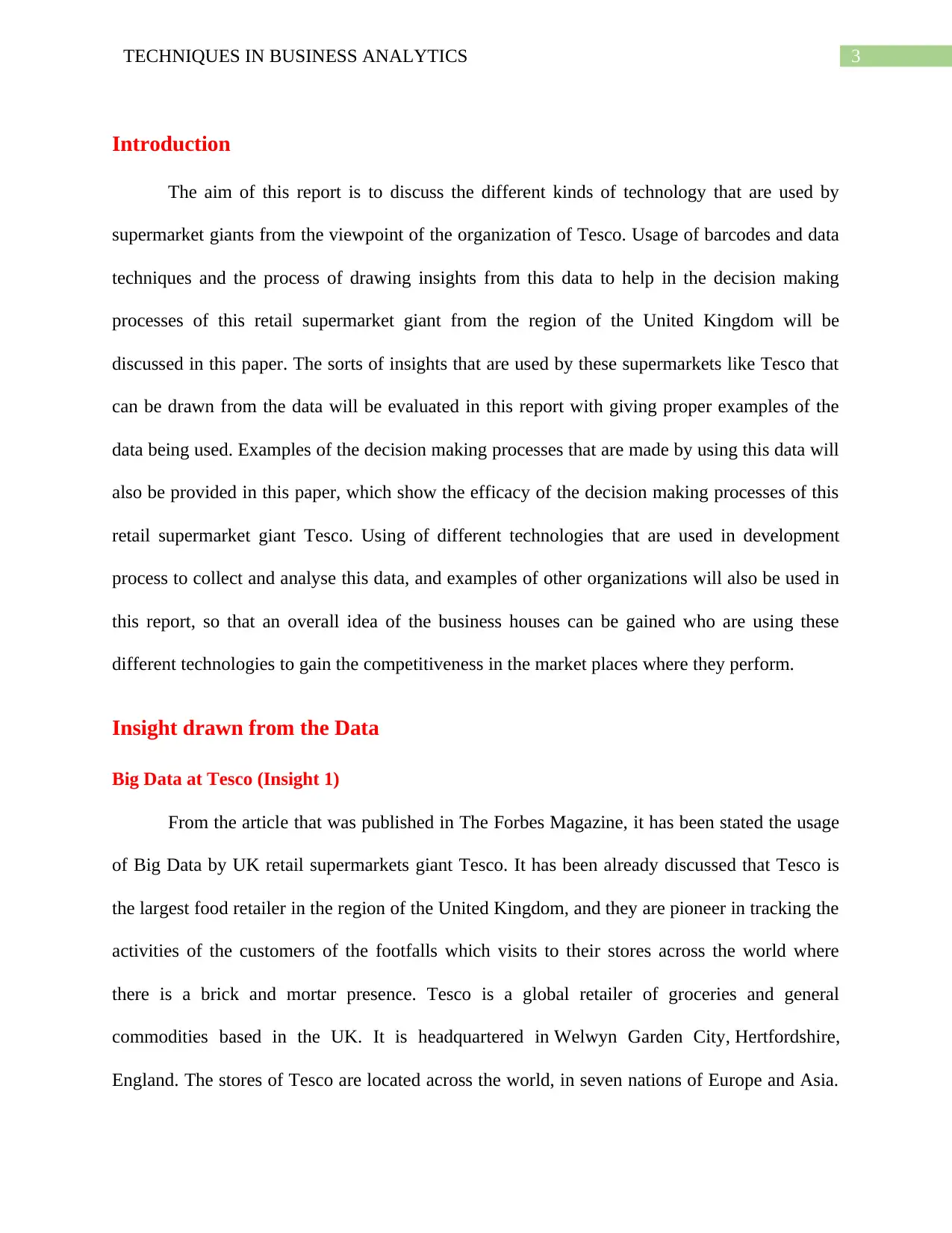
3TECHNIQUES IN BUSINESS ANALYTICS
Introduction
The aim of this report is to discuss the different kinds of technology that are used by
supermarket giants from the viewpoint of the organization of Tesco. Usage of barcodes and data
techniques and the process of drawing insights from this data to help in the decision making
processes of this retail supermarket giant from the region of the United Kingdom will be
discussed in this paper. The sorts of insights that are used by these supermarkets like Tesco that
can be drawn from the data will be evaluated in this report with giving proper examples of the
data being used. Examples of the decision making processes that are made by using this data will
also be provided in this paper, which show the efficacy of the decision making processes of this
retail supermarket giant Tesco. Using of different technologies that are used in development
process to collect and analyse this data, and examples of other organizations will also be used in
this report, so that an overall idea of the business houses can be gained who are using these
different technologies to gain the competitiveness in the market places where they perform.
Insight drawn from the Data
Big Data at Tesco (Insight 1)
From the article that was published in The Forbes Magazine, it has been stated the usage
of Big Data by UK retail supermarkets giant Tesco. It has been already discussed that Tesco is
the largest food retailer in the region of the United Kingdom, and they are pioneer in tracking the
activities of the customers of the footfalls which visits to their stores across the world where
there is a brick and mortar presence. Tesco is a global retailer of groceries and general
commodities based in the UK. It is headquartered in Welwyn Garden City, Hertfordshire,
England. The stores of Tesco are located across the world, in seven nations of Europe and Asia.
Introduction
The aim of this report is to discuss the different kinds of technology that are used by
supermarket giants from the viewpoint of the organization of Tesco. Usage of barcodes and data
techniques and the process of drawing insights from this data to help in the decision making
processes of this retail supermarket giant from the region of the United Kingdom will be
discussed in this paper. The sorts of insights that are used by these supermarkets like Tesco that
can be drawn from the data will be evaluated in this report with giving proper examples of the
data being used. Examples of the decision making processes that are made by using this data will
also be provided in this paper, which show the efficacy of the decision making processes of this
retail supermarket giant Tesco. Using of different technologies that are used in development
process to collect and analyse this data, and examples of other organizations will also be used in
this report, so that an overall idea of the business houses can be gained who are using these
different technologies to gain the competitiveness in the market places where they perform.
Insight drawn from the Data
Big Data at Tesco (Insight 1)
From the article that was published in The Forbes Magazine, it has been stated the usage
of Big Data by UK retail supermarkets giant Tesco. It has been already discussed that Tesco is
the largest food retailer in the region of the United Kingdom, and they are pioneer in tracking the
activities of the customers of the footfalls which visits to their stores across the world where
there is a brick and mortar presence. Tesco is a global retailer of groceries and general
commodities based in the UK. It is headquartered in Welwyn Garden City, Hertfordshire,
England. The stores of Tesco are located across the world, in seven nations of Europe and Asia.
Paraphrase This Document
Need a fresh take? Get an instant paraphrase of this document with our AI Paraphraser

4TECHNIQUES IN BUSINESS ANALYTICS
It is the leading grocery market in the UK having market shares of almost 28.4%. Founded by
Hack Cohen in the year 1919, Tesco was a group of market stalls. The first Tesco store was
opened in Burnt Oak, Barnet in 1931 after the name was coined. The company has expanded
hugely across the globe since the early 1900s, and got diversified in multiple areas that include
furniture, clothing, toys, books, electronics, telecoms and internet services, software, petrol as
well as financial services. Tesco has successfully attracted a large number of social groups by
offering products that ranged from “Tesco Value” items that were low cost to its “Tesco Finest”
range (tesco.com 2020).
Loyalty cards system are used by the management of this supermarket chain and are
successful in managing the transition to the overall online retailing process. But, it can be said
that advancement in the area of technologies has both pros and cons, and the same is faced by
this retail supermarket giant as well. The data analytics of real time along with implementation of
Big Data and other efficiencies related to advancements in the technology has been made
possible due to the rise of Internet of Things. The future of the retailing business that is
performed by Tesco will plan an active part through using all these advance forms of technology.
Application of leading analytics along with the updated data in the supermarket retain chain
business operations by Tesco, which has helped to identify the alterations in the behaviours of
the consumers and dealing with the obstacles that are faced by the management of this business
house from the region of the United Kingdom (Davenport and Dyché 2013).
Added Benefits (Insight 2)
It also helps to gain the power of facing the competition from the rival business entities in
all the market places where they are performing along with the competitiveness that will
ultimately help the management of Tesco to move ahead from their competitors. Tesco plans to
It is the leading grocery market in the UK having market shares of almost 28.4%. Founded by
Hack Cohen in the year 1919, Tesco was a group of market stalls. The first Tesco store was
opened in Burnt Oak, Barnet in 1931 after the name was coined. The company has expanded
hugely across the globe since the early 1900s, and got diversified in multiple areas that include
furniture, clothing, toys, books, electronics, telecoms and internet services, software, petrol as
well as financial services. Tesco has successfully attracted a large number of social groups by
offering products that ranged from “Tesco Value” items that were low cost to its “Tesco Finest”
range (tesco.com 2020).
Loyalty cards system are used by the management of this supermarket chain and are
successful in managing the transition to the overall online retailing process. But, it can be said
that advancement in the area of technologies has both pros and cons, and the same is faced by
this retail supermarket giant as well. The data analytics of real time along with implementation of
Big Data and other efficiencies related to advancements in the technology has been made
possible due to the rise of Internet of Things. The future of the retailing business that is
performed by Tesco will plan an active part through using all these advance forms of technology.
Application of leading analytics along with the updated data in the supermarket retain chain
business operations by Tesco, which has helped to identify the alterations in the behaviours of
the consumers and dealing with the obstacles that are faced by the management of this business
house from the region of the United Kingdom (Davenport and Dyché 2013).
Added Benefits (Insight 2)
It also helps to gain the power of facing the competition from the rival business entities in
all the market places where they are performing along with the competitiveness that will
ultimately help the management of Tesco to move ahead from their competitors. Tesco plans to
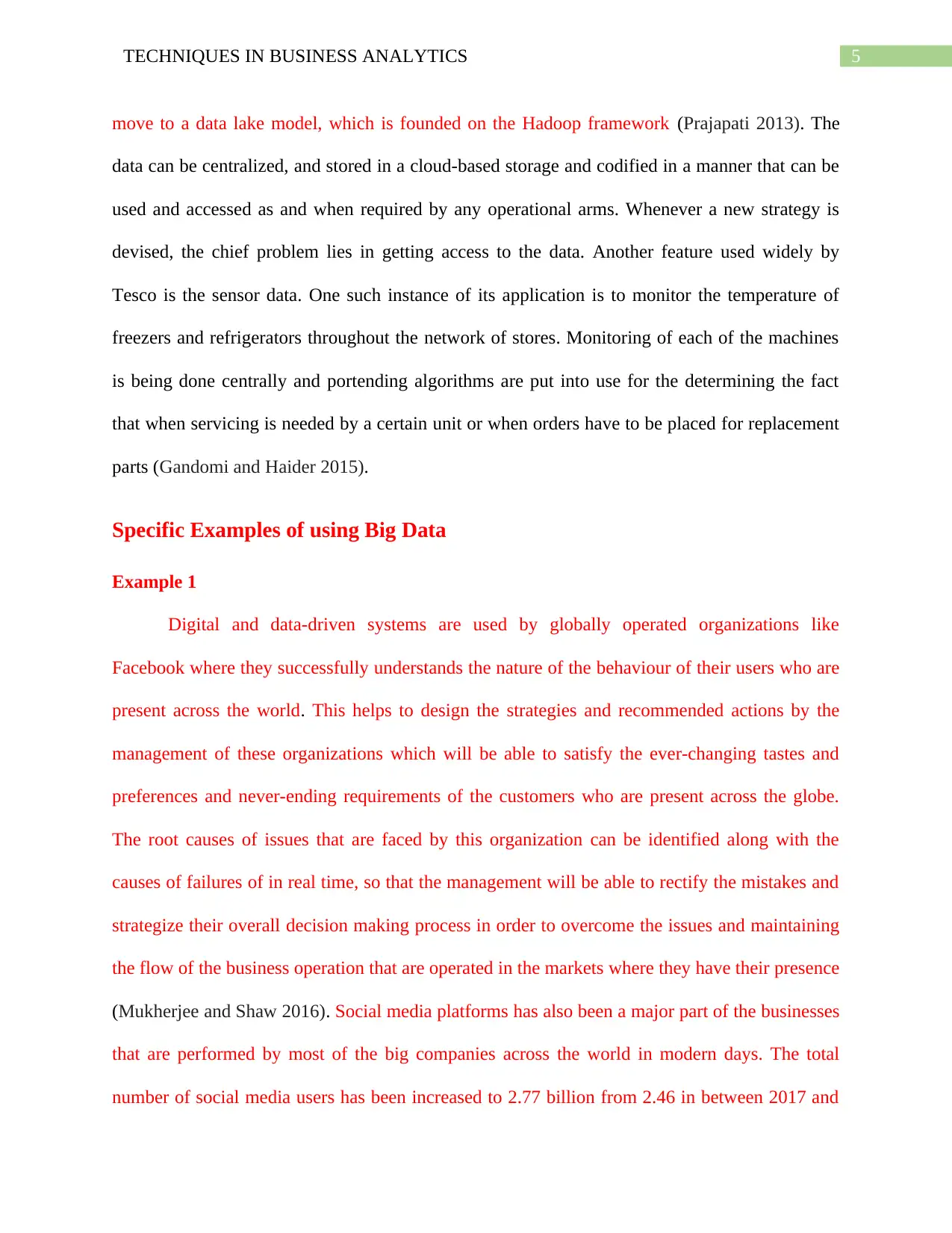
5TECHNIQUES IN BUSINESS ANALYTICS
move to a data lake model, which is founded on the Hadoop framework (Prajapati 2013). The
data can be centralized, and stored in a cloud-based storage and codified in a manner that can be
used and accessed as and when required by any operational arms. Whenever a new strategy is
devised, the chief problem lies in getting access to the data. Another feature used widely by
Tesco is the sensor data. One such instance of its application is to monitor the temperature of
freezers and refrigerators throughout the network of stores. Monitoring of each of the machines
is being done centrally and portending algorithms are put into use for the determining the fact
that when servicing is needed by a certain unit or when orders have to be placed for replacement
parts (Gandomi and Haider 2015).
Specific Examples of using Big Data
Example 1
Digital and data-driven systems are used by globally operated organizations like
Facebook where they successfully understands the nature of the behaviour of their users who are
present across the world. This helps to design the strategies and recommended actions by the
management of these organizations which will be able to satisfy the ever-changing tastes and
preferences and never-ending requirements of the customers who are present across the globe.
The root causes of issues that are faced by this organization can be identified along with the
causes of failures of in real time, so that the management will be able to rectify the mistakes and
strategize their overall decision making process in order to overcome the issues and maintaining
the flow of the business operation that are operated in the markets where they have their presence
(Mukherjee and Shaw 2016). Social media platforms has also been a major part of the businesses
that are performed by most of the big companies across the world in modern days. The total
number of social media users has been increased to 2.77 billion from 2.46 in between 2017 and
move to a data lake model, which is founded on the Hadoop framework (Prajapati 2013). The
data can be centralized, and stored in a cloud-based storage and codified in a manner that can be
used and accessed as and when required by any operational arms. Whenever a new strategy is
devised, the chief problem lies in getting access to the data. Another feature used widely by
Tesco is the sensor data. One such instance of its application is to monitor the temperature of
freezers and refrigerators throughout the network of stores. Monitoring of each of the machines
is being done centrally and portending algorithms are put into use for the determining the fact
that when servicing is needed by a certain unit or when orders have to be placed for replacement
parts (Gandomi and Haider 2015).
Specific Examples of using Big Data
Example 1
Digital and data-driven systems are used by globally operated organizations like
Facebook where they successfully understands the nature of the behaviour of their users who are
present across the world. This helps to design the strategies and recommended actions by the
management of these organizations which will be able to satisfy the ever-changing tastes and
preferences and never-ending requirements of the customers who are present across the globe.
The root causes of issues that are faced by this organization can be identified along with the
causes of failures of in real time, so that the management will be able to rectify the mistakes and
strategize their overall decision making process in order to overcome the issues and maintaining
the flow of the business operation that are operated in the markets where they have their presence
(Mukherjee and Shaw 2016). Social media platforms has also been a major part of the businesses
that are performed by most of the big companies across the world in modern days. The total
number of social media users has been increased to 2.77 billion from 2.46 in between 2017 and
⊘ This is a preview!⊘
Do you want full access?
Subscribe today to unlock all pages.

Trusted by 1+ million students worldwide
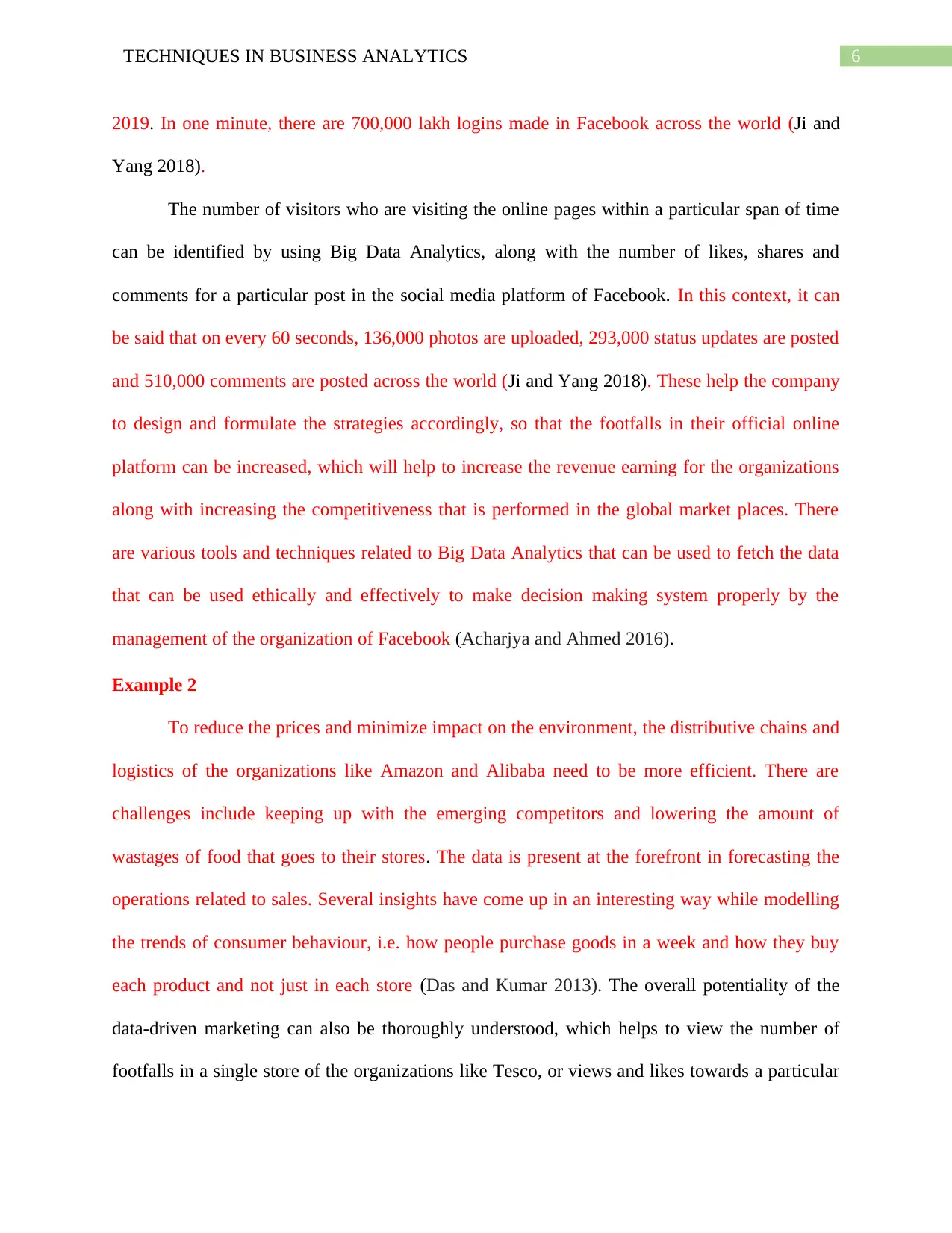
6TECHNIQUES IN BUSINESS ANALYTICS
2019. In one minute, there are 700,000 lakh logins made in Facebook across the world (Ji and
Yang 2018).
The number of visitors who are visiting the online pages within a particular span of time
can be identified by using Big Data Analytics, along with the number of likes, shares and
comments for a particular post in the social media platform of Facebook. In this context, it can
be said that on every 60 seconds, 136,000 photos are uploaded, 293,000 status updates are posted
and 510,000 comments are posted across the world (Ji and Yang 2018). These help the company
to design and formulate the strategies accordingly, so that the footfalls in their official online
platform can be increased, which will help to increase the revenue earning for the organizations
along with increasing the competitiveness that is performed in the global market places. There
are various tools and techniques related to Big Data Analytics that can be used to fetch the data
that can be used ethically and effectively to make decision making system properly by the
management of the organization of Facebook (Acharjya and Ahmed 2016).
Example 2
To reduce the prices and minimize impact on the environment, the distributive chains and
logistics of the organizations like Amazon and Alibaba need to be more efficient. There are
challenges include keeping up with the emerging competitors and lowering the amount of
wastages of food that goes to their stores. The data is present at the forefront in forecasting the
operations related to sales. Several insights have come up in an interesting way while modelling
the trends of consumer behaviour, i.e. how people purchase goods in a week and how they buy
each product and not just in each store (Das and Kumar 2013). The overall potentiality of the
data-driven marketing can also be thoroughly understood, which helps to view the number of
footfalls in a single store of the organizations like Tesco, or views and likes towards a particular
2019. In one minute, there are 700,000 lakh logins made in Facebook across the world (Ji and
Yang 2018).
The number of visitors who are visiting the online pages within a particular span of time
can be identified by using Big Data Analytics, along with the number of likes, shares and
comments for a particular post in the social media platform of Facebook. In this context, it can
be said that on every 60 seconds, 136,000 photos are uploaded, 293,000 status updates are posted
and 510,000 comments are posted across the world (Ji and Yang 2018). These help the company
to design and formulate the strategies accordingly, so that the footfalls in their official online
platform can be increased, which will help to increase the revenue earning for the organizations
along with increasing the competitiveness that is performed in the global market places. There
are various tools and techniques related to Big Data Analytics that can be used to fetch the data
that can be used ethically and effectively to make decision making system properly by the
management of the organization of Facebook (Acharjya and Ahmed 2016).
Example 2
To reduce the prices and minimize impact on the environment, the distributive chains and
logistics of the organizations like Amazon and Alibaba need to be more efficient. There are
challenges include keeping up with the emerging competitors and lowering the amount of
wastages of food that goes to their stores. The data is present at the forefront in forecasting the
operations related to sales. Several insights have come up in an interesting way while modelling
the trends of consumer behaviour, i.e. how people purchase goods in a week and how they buy
each product and not just in each store (Das and Kumar 2013). The overall potentiality of the
data-driven marketing can also be thoroughly understood, which helps to view the number of
footfalls in a single store of the organizations like Tesco, or views and likes towards a particular
Paraphrase This Document
Need a fresh take? Get an instant paraphrase of this document with our AI Paraphraser
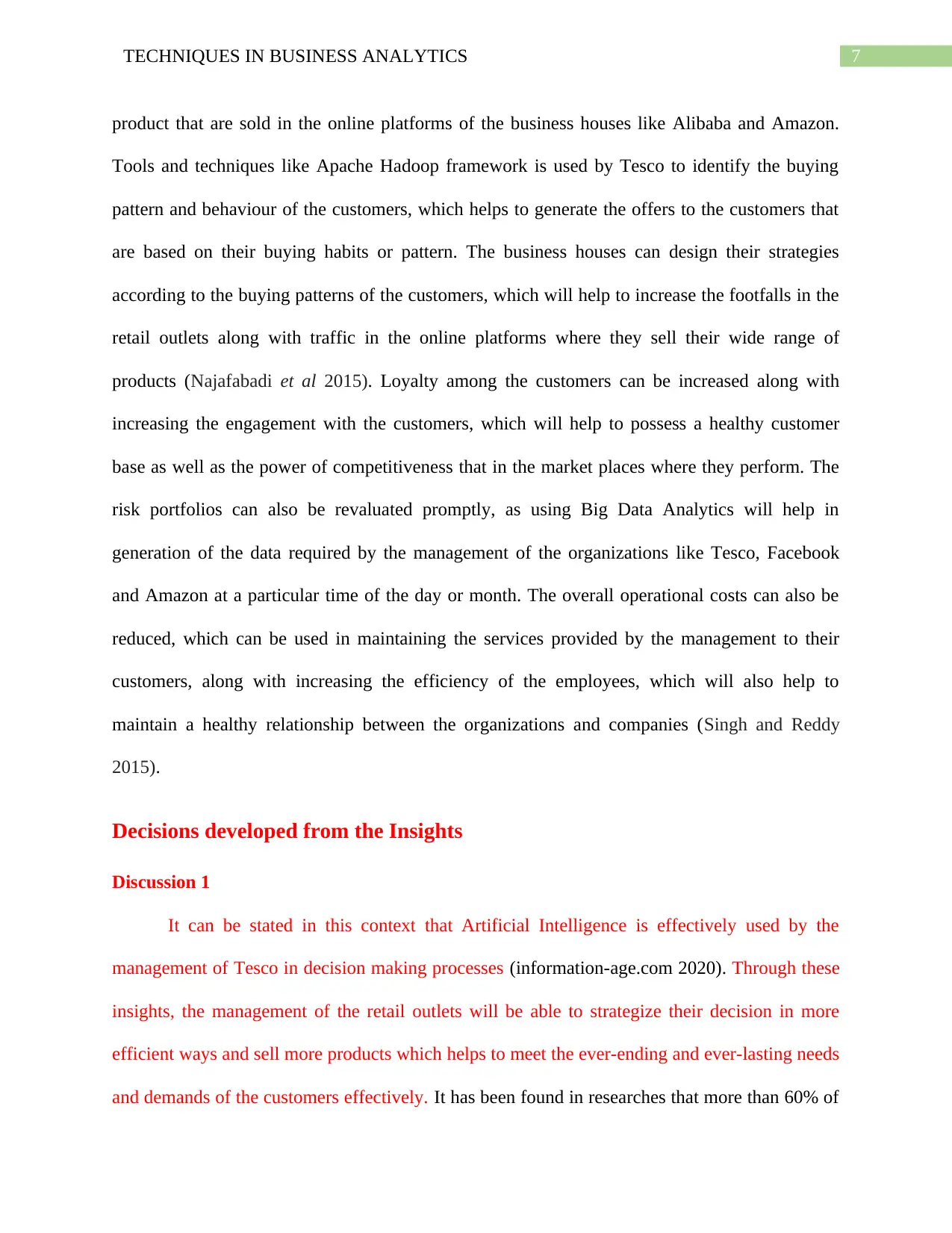
7TECHNIQUES IN BUSINESS ANALYTICS
product that are sold in the online platforms of the business houses like Alibaba and Amazon.
Tools and techniques like Apache Hadoop framework is used by Tesco to identify the buying
pattern and behaviour of the customers, which helps to generate the offers to the customers that
are based on their buying habits or pattern. The business houses can design their strategies
according to the buying patterns of the customers, which will help to increase the footfalls in the
retail outlets along with traffic in the online platforms where they sell their wide range of
products (Najafabadi et al 2015). Loyalty among the customers can be increased along with
increasing the engagement with the customers, which will help to possess a healthy customer
base as well as the power of competitiveness that in the market places where they perform. The
risk portfolios can also be revaluated promptly, as using Big Data Analytics will help in
generation of the data required by the management of the organizations like Tesco, Facebook
and Amazon at a particular time of the day or month. The overall operational costs can also be
reduced, which can be used in maintaining the services provided by the management to their
customers, along with increasing the efficiency of the employees, which will also help to
maintain a healthy relationship between the organizations and companies (Singh and Reddy
2015).
Decisions developed from the Insights
Discussion 1
It can be stated in this context that Artificial Intelligence is effectively used by the
management of Tesco in decision making processes (information-age.com 2020). Through these
insights, the management of the retail outlets will be able to strategize their decision in more
efficient ways and sell more products which helps to meet the ever-ending and ever-lasting needs
and demands of the customers effectively. It has been found in researches that more than 60% of
product that are sold in the online platforms of the business houses like Alibaba and Amazon.
Tools and techniques like Apache Hadoop framework is used by Tesco to identify the buying
pattern and behaviour of the customers, which helps to generate the offers to the customers that
are based on their buying habits or pattern. The business houses can design their strategies
according to the buying patterns of the customers, which will help to increase the footfalls in the
retail outlets along with traffic in the online platforms where they sell their wide range of
products (Najafabadi et al 2015). Loyalty among the customers can be increased along with
increasing the engagement with the customers, which will help to possess a healthy customer
base as well as the power of competitiveness that in the market places where they perform. The
risk portfolios can also be revaluated promptly, as using Big Data Analytics will help in
generation of the data required by the management of the organizations like Tesco, Facebook
and Amazon at a particular time of the day or month. The overall operational costs can also be
reduced, which can be used in maintaining the services provided by the management to their
customers, along with increasing the efficiency of the employees, which will also help to
maintain a healthy relationship between the organizations and companies (Singh and Reddy
2015).
Decisions developed from the Insights
Discussion 1
It can be stated in this context that Artificial Intelligence is effectively used by the
management of Tesco in decision making processes (information-age.com 2020). Through these
insights, the management of the retail outlets will be able to strategize their decision in more
efficient ways and sell more products which helps to meet the ever-ending and ever-lasting needs
and demands of the customers effectively. It has been found in researches that more than 60% of
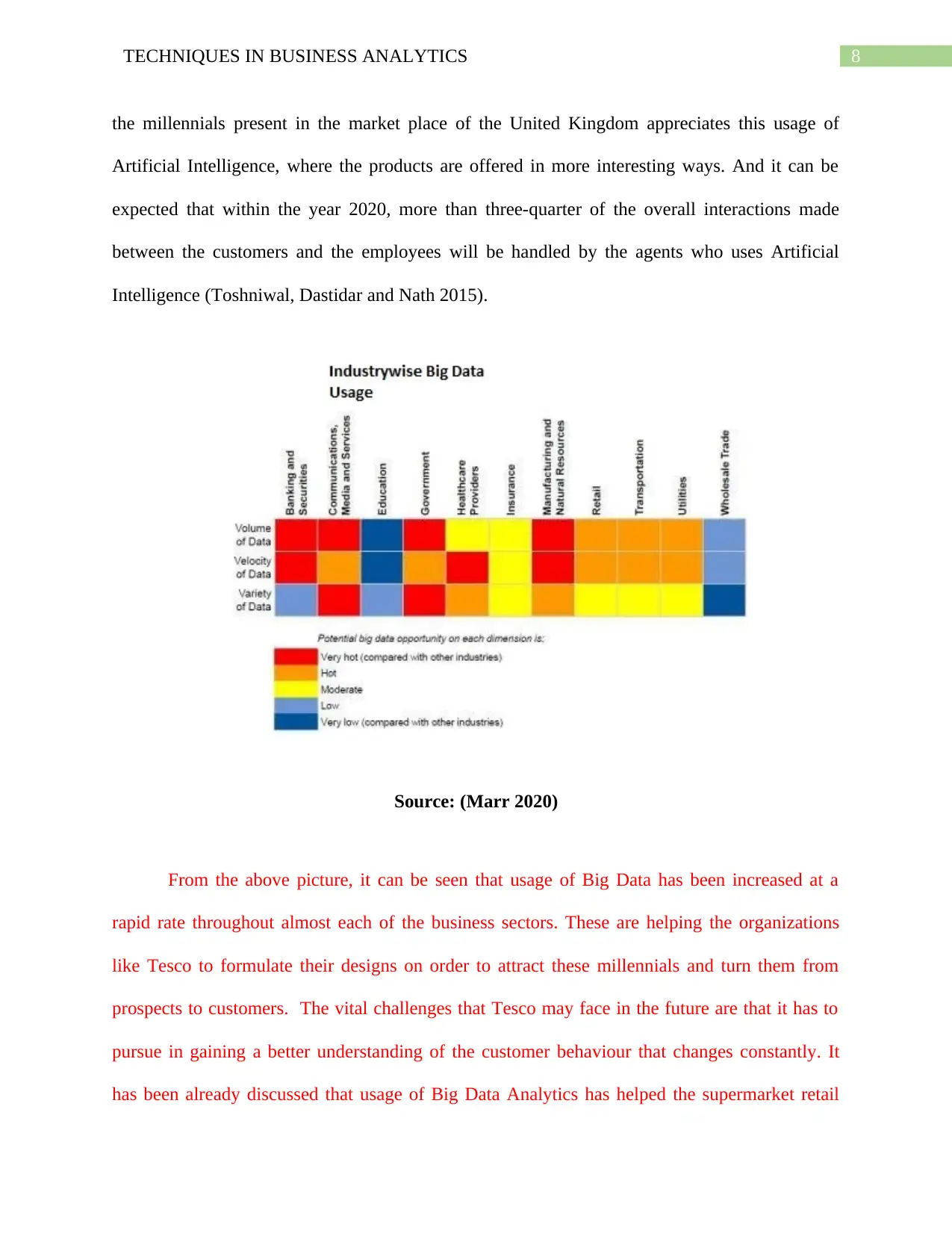
8TECHNIQUES IN BUSINESS ANALYTICS
the millennials present in the market place of the United Kingdom appreciates this usage of
Artificial Intelligence, where the products are offered in more interesting ways. And it can be
expected that within the year 2020, more than three-quarter of the overall interactions made
between the customers and the employees will be handled by the agents who uses Artificial
Intelligence (Toshniwal, Dastidar and Nath 2015).
Source: (Marr 2020)
From the above picture, it can be seen that usage of Big Data has been increased at a
rapid rate throughout almost each of the business sectors. These are helping the organizations
like Tesco to formulate their designs on order to attract these millennials and turn them from
prospects to customers. The vital challenges that Tesco may face in the future are that it has to
pursue in gaining a better understanding of the customer behaviour that changes constantly. It
has been already discussed that usage of Big Data Analytics has helped the supermarket retail
the millennials present in the market place of the United Kingdom appreciates this usage of
Artificial Intelligence, where the products are offered in more interesting ways. And it can be
expected that within the year 2020, more than three-quarter of the overall interactions made
between the customers and the employees will be handled by the agents who uses Artificial
Intelligence (Toshniwal, Dastidar and Nath 2015).
Source: (Marr 2020)
From the above picture, it can be seen that usage of Big Data has been increased at a
rapid rate throughout almost each of the business sectors. These are helping the organizations
like Tesco to formulate their designs on order to attract these millennials and turn them from
prospects to customers. The vital challenges that Tesco may face in the future are that it has to
pursue in gaining a better understanding of the customer behaviour that changes constantly. It
has been already discussed that usage of Big Data Analytics has helped the supermarket retail
⊘ This is a preview!⊘
Do you want full access?
Subscribe today to unlock all pages.

Trusted by 1+ million students worldwide

9TECHNIQUES IN BUSINESS ANALYTICS
giants like Tesco and other business entities, which helps to identify and track the behaviours of
the consumers.
Decision 2
It has been already discussed that data along with technology is efficiently used by Tesco,
and they are one of the first supermarket chain who has successfully tracked the activities of the
customers who are visiting their stores along with using the online platform of Tesco. With
having 3,500 stores only in the region of the United Kingdom the UK alone, and 40,000 products
on an average are present in a single store, more than 100 million data points can be created by
using Big Data Analytics. The management of Tesco is thinking of shifting to a data lake model
from a data warehousing, which is based around the Hadoop framework, so that it will help to
make better decisions in the global competitive retail market (Tsai et al 2015). Big Data is
regarded as one of the most important source of valuable insights which is used by the
companies for making better decisions along with designing strategic moves to speed up the
growth of the business. Tracking all the buying pattern and behaviour of the customers along
with tracking the trends of the modern lifestyle followed by the customers can be effectively
followed, which will help to make proper and ethical decisions by these business houses to gain
the competitive advantage against the rival institutions that operates in the market places where
they perform. Social media platform also plays an active part in gathering the data, where major
challenges are faced from customers, rival business entities, rising cost of materials and labour
and shorter lifecycles of product (Wang, Wang and Alexander 2015).
Conclusion
From the above discussion, it can be said that Big Data Analytics possess the potentiality
to transform the business operations through the decision making processes, and helps to gain lot
giants like Tesco and other business entities, which helps to identify and track the behaviours of
the consumers.
Decision 2
It has been already discussed that data along with technology is efficiently used by Tesco,
and they are one of the first supermarket chain who has successfully tracked the activities of the
customers who are visiting their stores along with using the online platform of Tesco. With
having 3,500 stores only in the region of the United Kingdom the UK alone, and 40,000 products
on an average are present in a single store, more than 100 million data points can be created by
using Big Data Analytics. The management of Tesco is thinking of shifting to a data lake model
from a data warehousing, which is based around the Hadoop framework, so that it will help to
make better decisions in the global competitive retail market (Tsai et al 2015). Big Data is
regarded as one of the most important source of valuable insights which is used by the
companies for making better decisions along with designing strategic moves to speed up the
growth of the business. Tracking all the buying pattern and behaviour of the customers along
with tracking the trends of the modern lifestyle followed by the customers can be effectively
followed, which will help to make proper and ethical decisions by these business houses to gain
the competitive advantage against the rival institutions that operates in the market places where
they perform. Social media platform also plays an active part in gathering the data, where major
challenges are faced from customers, rival business entities, rising cost of materials and labour
and shorter lifecycles of product (Wang, Wang and Alexander 2015).
Conclusion
From the above discussion, it can be said that Big Data Analytics possess the potentiality
to transform the business operations through the decision making processes, and helps to gain lot
Paraphrase This Document
Need a fresh take? Get an instant paraphrase of this document with our AI Paraphraser

10TECHNIQUES IN BUSINESS ANALYTICS
of insights from the data gathered by using various tools and technologies like Artificial
Intelligence, Hadoop Framework and others. The popularity of following this process is
increasing gradually among all the business industries, and the same is followed by organizations
like Tesco, Facebook, Amazon and others efficiently and effectively.
of insights from the data gathered by using various tools and technologies like Artificial
Intelligence, Hadoop Framework and others. The popularity of following this process is
increasing gradually among all the business industries, and the same is followed by organizations
like Tesco, Facebook, Amazon and others efficiently and effectively.

11TECHNIQUES IN BUSINESS ANALYTICS
References
Acharjya, D.P. and Ahmed, K., 2016. A survey on big data analytics: challenges, open research
issues and tools. International Journal of Advanced Computer Science and Applications, 7(2),
pp.511-518.
Das, T.K. and Kumar, P.M., 2013. Big data analytics: A framework for unstructured data
analysis. International Journal of Engineering Science & Technology, 5(1), p.153.
Davenport, T.H. and Dyché, J., 2013. Big data in big companies. International Institute for
Analytics, 3.
Gandomi, A. and Haider, M., 2015. Beyond the hype: Big data concepts, methods, and
analytics. International journal of information management, 35(2), pp.137-144.
Information Age. 2020. How Tesco Is Using AI To Gain Customer Insight - Information Age.
[online] Available at: <https://www.information-age.com/tesco-using-ai-gain-customer-insight-
123466328/> [Accessed 10 April 2020].
Ji, Y.G. and Yang, A., 2018, March. Sustainability Alliance Networks on Facebook: A Big Data
Network Analysis of S&P 500 Environmental Responsibility Initiatives on Facebook. In 21 ST
INTERNATIONAL PUBLIC RELATIONS RESEARCH CONFERENCE (p. 140).
Marr, B., 2020. Big Data At Tesco: Real Time Analytics At The UK Grocery Retail Giant.
[online] Forbes. Available at: <https://www.forbes.com/sites/bernardmarr/2016/11/17/big-data-
at-tesco-real-time-analytics-at-the-uk-grocery-retail-giant/#4647ecc561cf> [Accessed 10 April
2020].
Mukherjee, S. and Shaw, R., 2016. Big data–concepts, applications, challenges and future
scope. International Journal of Advanced Research in Computer and Communication
Engineering, 5(2), pp.66-74.
References
Acharjya, D.P. and Ahmed, K., 2016. A survey on big data analytics: challenges, open research
issues and tools. International Journal of Advanced Computer Science and Applications, 7(2),
pp.511-518.
Das, T.K. and Kumar, P.M., 2013. Big data analytics: A framework for unstructured data
analysis. International Journal of Engineering Science & Technology, 5(1), p.153.
Davenport, T.H. and Dyché, J., 2013. Big data in big companies. International Institute for
Analytics, 3.
Gandomi, A. and Haider, M., 2015. Beyond the hype: Big data concepts, methods, and
analytics. International journal of information management, 35(2), pp.137-144.
Information Age. 2020. How Tesco Is Using AI To Gain Customer Insight - Information Age.
[online] Available at: <https://www.information-age.com/tesco-using-ai-gain-customer-insight-
123466328/> [Accessed 10 April 2020].
Ji, Y.G. and Yang, A., 2018, March. Sustainability Alliance Networks on Facebook: A Big Data
Network Analysis of S&P 500 Environmental Responsibility Initiatives on Facebook. In 21 ST
INTERNATIONAL PUBLIC RELATIONS RESEARCH CONFERENCE (p. 140).
Marr, B., 2020. Big Data At Tesco: Real Time Analytics At The UK Grocery Retail Giant.
[online] Forbes. Available at: <https://www.forbes.com/sites/bernardmarr/2016/11/17/big-data-
at-tesco-real-time-analytics-at-the-uk-grocery-retail-giant/#4647ecc561cf> [Accessed 10 April
2020].
Mukherjee, S. and Shaw, R., 2016. Big data–concepts, applications, challenges and future
scope. International Journal of Advanced Research in Computer and Communication
Engineering, 5(2), pp.66-74.
⊘ This is a preview!⊘
Do you want full access?
Subscribe today to unlock all pages.

Trusted by 1+ million students worldwide
1 out of 13
Related Documents
Your All-in-One AI-Powered Toolkit for Academic Success.
+13062052269
info@desklib.com
Available 24*7 on WhatsApp / Email
![[object Object]](/_next/static/media/star-bottom.7253800d.svg)
Unlock your academic potential
Copyright © 2020–2025 A2Z Services. All Rights Reserved. Developed and managed by ZUCOL.




